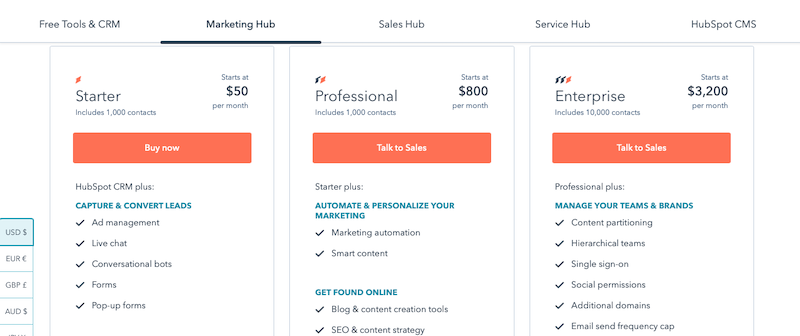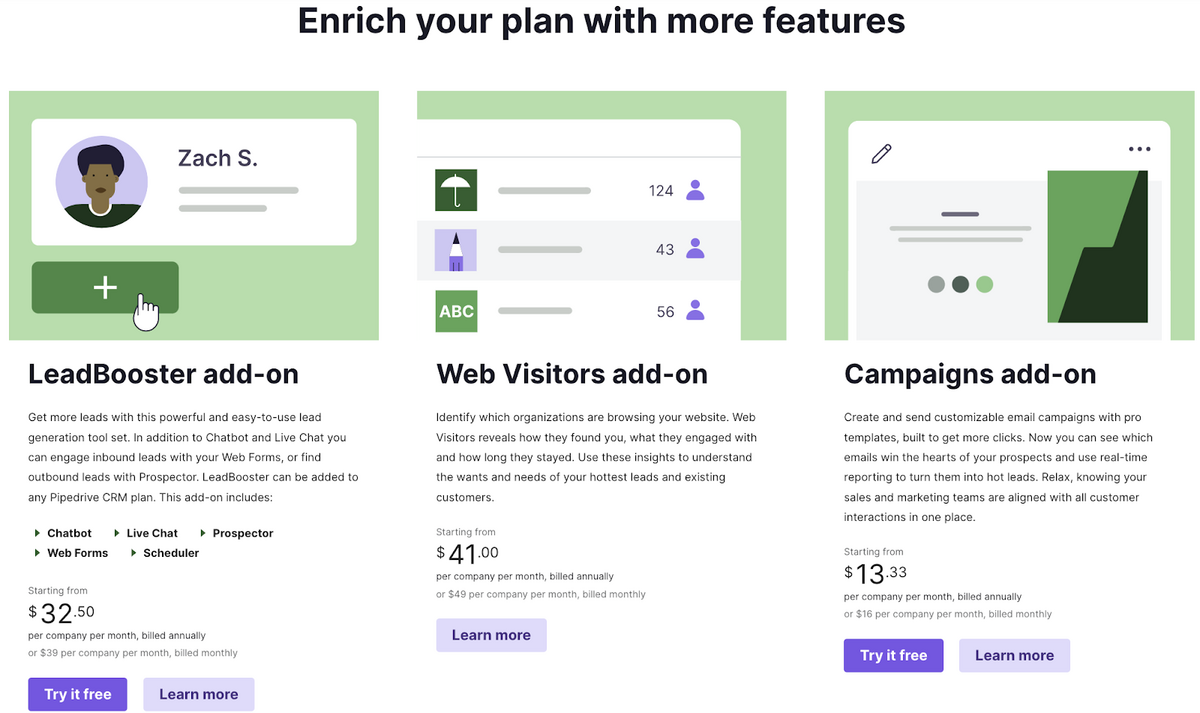If you’re thinking of switching to recurring billing, there are several popular pricing models you need to learn about.
These are flat-rate, tiered, per-feature, per-user, and usage-based pricing.
A solid understanding of each model will allow you to pick the best one for your specific service business, the one that will lead to increased efficiency, higher sales, and more revenue.
Read on to learn the pros and cons of the major pricing models and to see some examples of how companies use them effectively.
- Flat-Rate Pricing Strategy
- Tiered Pricing
- Per-Feature Strategy
- Per-User Pricing Strategy
- Usage-Based Pricing
- Conclusion
Flat-Rate Pricing Strategy
Flat-rate pricing, also known as fixed-rate recurring billing, is when customers are charged the same price at recurring intervals. That could be $9.99 per month or $100 per year.
In any case, the pricing doesn’t fluctuate.
For example, Audible uses a flat-rate pricing strategy for its subscription service:

Source: Audible
Audible Plus customers are charged $7.95 per month, regardless of how often they use the service.
One of the major advantages of flat-rate pricing is its simplicity. Because it’s so easy to explain to customers, it’s also easy to sell.
It also really streamlines the research phase in the customer journey.
Prospective buyers don’t have to learn the ins and outs of your multiple pricing tiers before they feel comfortable enough to make a purchase. Instead, they just have to learn about one plan.
Once they’ve bought your service, customers will also enjoy the predictability of the payments. Every period they’ll pay the same amount.
This allows them to create and stick to their budgets.
Companies that are best set to benefit from flat-rate pricing are those with a pretty narrow service and a homogenous customer base.
If most of your customers have similar needs and budgets, and your tool is a point solution, then a one-size fits all pricing model might work for you.
This one-size fits all element of flat-rate pricing, however, can also be a disadvantage to some businesses.
If you have a wide variety of customer personas, then you might want to offer more variety in your pricing plans.
For example, HubSpot sells to Fortune 500 businesses and freelancers, so they offer multiple pricing tiers to ensure everyone can find a plan that fits their needs:

Source: Capiche
If they only offered one pricing package, they’d lose out on a lot of potential customers. For some people, they’d either charge too much or offer too few features.
That said, flat-rate pricing still has its place. If you want to quickly set up fixed recurring billing plans for your customers, and charge them automatically, consider trying Regpack, an automated billing software solution that’s incredibly easy to use.
The platform allows you to accept and securely process multiple forms of payment, including ACH bank transfers and credit card payments.
This gives your customers the payment flexibility they crave.
In sum, flat-rate pricing is a good option for businesses that value simplicity and want to be able to communicate the pricing of their service with ease.
Tiered Pricing
Tiered pricing is a recurring billing strategy where a company offers different versions or tiers of a product or service at different price points.
The most affordable version, sometimes even free, is the least advanced, offering only the most basic features. Meanwhile, the most expensive version is also the most advanced.
This is an incredibly dominant pricing model in the SaaS ecosystem. It enables them to cater to various buyer personas and capture a large audience.
For example, a SaaS company like Pipedrive offers its customers four pricing tiers:

Source: Pipedrive
Because tiered pricing allows you to offer a low price with basic features, it also reduces the barrier to entry, making it easier to attract and close new customers.
Essentially, the lowest plan helps you get people into the door. And once they’re in, it’s easier to convince them to try out the benefits of the more expensive service plans.
This leads us to another benefit of tiered pricing—it lends itself well to upselling.
Customers who love their basic plan will likely, at some point, start to wonder about the features in the more advanced tiers.
They already trust your brand, so once you’ve sparked their interest, it doesn’t take much convincing to get them to buy the upgrade.
For example, take this subscription service that offers online education in English Literature, called Hardcore Literature:

Source: Patreon
A customer who’s been using the Proust plan for a year trusts the teacher and has developed their interest in literature to a point where they’re craving more content.
They might also want to put what they’ve learned to work in conversation with the teacher and fellow students. This will all culminate in their upgrading to the Shakespeare plan.
In short, tiered pricing models allow you to tailor your pricing to various different categories of customers.
To implement it, you’ll have to create different service types, which will require some creativity and hard work. But it’s often worth it in the end if this pricing model fits your needs.
Per-Feature Strategy
The per-feature strategy is when customers are charged a recurring amount based on the number of features of the product or service they use.
Some examples include:
| A tutoring service charges extra for features like homework help or access to online videos. |
| Summer camps offer parents the ability to pay more for after-hour childcare. |
| A CRM charges extra for special features like email automation or web visitor tracking. |
| A sales prospecting Chrome extension may charge 10 cents for every time you uncover a LinkedIn user’s contact information. |
One of the major advantages of offering per-feature pricing is that your customers only have to pay for what they want. They’ll feel that the pricing is fair.
For example, imagine a gym customer who only wants to hit the squat rack and bench press.
If they find a gym that offers access to nothing but the weight room facilities for $30 per month, they’ll be satisfied with this amount.
On the other hand, if the gym charged $50 per month and the price included five free monthly workout classes held at the gym, this weightlifter might be annoyed knowing that they’ll never use the classes.
Therefore, the gym should use feature-based pricing to please both the class/gym user and the gym-only user.
For example, they could charge a flat fee of $30 per month for gym access, but give customers the option to pay $20 extra per month to get the classes.
Often, companies choose to use this pricing model in tandem with either the flat rate or the tiered pricing.
For example, Pipedrive uses tiered-based pricing. Customers can choose between four plans.
But they also offer add-on features that users can tack on to their current plan for an extra monthly charge:

Source: Pipedrive
This is probably the best use of the per-feature strategy, as it keeps the straightforwardness of the tiered pricing model while allowing buyers to further customize their experience if they want.
A fully feature-based pricing model might become overly complicated for customers to understand, especially if you offer a lot of essential features.
To illustrate, if Pipedrive used a strictly feature-based model, they’d have to attach prices to about 100 different features.
This would be a nightmare for the pricing team to do, and customers would feel overwhelmed trying to decide which features they need.
It’s a much better user experience when Pipedrive tells users which features they’ll need, and lumps those into packages, then offers the more niche features that’ll resonate with a small segment of their buyers as add-ons.
Per-User Pricing Strategy
Per-user pricing is a recurring billing strategy where customers are charged depending on the number of people using the service through a single company account.
For example, that might be $14 per user per month.
This pricing strategy is most popular among software businesses selling to other businesses that will have multiple users.
For example, a marketing automation tool might charge per seat, knowing that their ideal customer’s marketing teams consist of multiple people.
Some businesses will put a per-seat limit on their different pricing tiers. Typically, the higher the pricing tier, the more people can use the software.
For instance, Mailchimp allows just one person to use their free plan, but lets unlimited users for their premium plan customers:

Source: Mailchimp
This technique is a good way to motivate customers to move up to more expensive plans as their team grows.
Other businesses will use a more true per-user pricing model, where they actually charge per user, per month, like the company below:

Source: Klood
One problem with this model is that it might turn off companies with large teams but small budgets.
A company that just wants the core features but wants their entire team to be able to access it might find the price too much to bear.
And if there are user limits, they might not even be able to use the plan they wanted.
Usage-Based Pricing
With usage-based pricing (or pay-as-you-go pricing), businesses charge customers based on how much they use the product or service.
It has been growing in popularity for years:

Source: OpenView Partners
Companies measure usage in various ways, but it’s usually connected to the activity or function that creates the most value for the user.
For example, an iPhone charges customers based on how much storage they’ve used, since this storage of photos, messages, and apps is the main value of the iPhone.
Here are some other examples of usage-based pricing:
| A CRM software company might charge based on the number of contacts in the system. |
| Utility companies charge according to how much water, electricity, or heat customers use. |
| Zapier charges customers based on how many task automations they create. |
Companies pick usage-based pricing for many reasons. For starters, it’s popular with many buyers, because of the tailored experience they receive.
Plus, customers can start at a low cost, making it easier for the business to close new customers who are on the fence.
It also leads to naturally rising revenue per customer.
As a relationship progresses, the buyer starts using the service more and more as they become increasingly familiar with and dependent on it.
Another valuable aspect of usage-based pricing is that customers feel completely in control. This makes them less likely to become frustrated with your business.
If a customer receives a large bill one month, they know that the only person to blame is themselves.
And if you did a good job of connecting the pricing to the value, customers shouldn’t feel bad for paying a lot, because it means they extracted a ton of value from your service that month.
If someone used a bunch of heat in the winter and was always toasty and comfortable, they won’t mind that the bills are high priced. They get their money’s worth.
Many businesses use usage-based pricing in tandem with tiered pricing, like Snowflake does below:

Source: Sapphire Ventures
As you go up in tier, the computing cost per credit rises.
Note that they also offer two add-on features below—on-demand storage and capacity storage—which are also priced based on usage.
This makes Snowflake a prime example of a company that uses a hybrid of three different recurring pricing strategies—tiered, usage, and per-feature.
On another note, one potential disadvantage of this model is that it makes cash flow a bit harder to predict since customers will pay different amounts each payment cycle.
But this can be overcome with solid customer analysis.
After a customer has been with you long enough, you should be able to use their historical data to predict how much they’re going to use your service in any given month.
Conclusion
Before selecting a pricing strategy for accepting recurring payments, you need to know your options.
Keep in mind that you aren’t confined to choosing just one payment model. You can combine different models to fit your unique needs.
To ensure that your chosen pricing model provides you with the benefits you desire, check out our article on recurring billing best practices, where you’ll find tips for creating a smooth, automated, and cost-effective billing system.



















